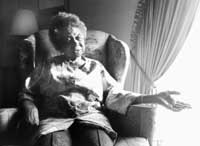|
HOME SEARCH ARCHIVE |
|
| |
 Oral history informant and retired Oakland realtor Edith Hill. James Chaing photo. |
The East Bay city, though much maligned, happens to be one of the most ethnically diverse and least residentially segregated cities in America. Its diversity dates back as long ago as 1860, when only a slight majority of Oakland residents were native-born Americans. A militant national black organization that worked with whites, the Black Panther Party, was born in Oakland. And in the 1980s, the Oakland Tribune was the only black-owned daily metropolitan newspaper in America.
In light of this history, how did the city come to have its diverse population of African Americans, European Americans, Asians and Latinos, many of whom share the same neighborhoods? And does its experience contain lessons for other cities?
Percy Hintzen, chairman of African American Studies, says that long-term Oakland residents with good memories and a wealth of personal experiences related to politics, labor, housing, education and culture hold answers to such questions.
He and a team of graduate students recently completed phase one of the Oakland Oral History Project, interviewing 18 individuals who lived or worked in "Oak Town" in the decade following World War II.
Informants include Hadwick Thompson, Oakland's first civil service police officer; Joseph Johnson, a personal friend of Paul Robeson and a renowned figure in the industrial labor movement and the black left; Margaret Saito, a second-generation Japanese American whose family was sent to a World War II relocation camp; and Walter Bachemin, the first black business agent for the Amalgamated Meatcutters' Union.
Informant Edith Hill, a black realtor who fought to desegregate Oakland's neighborhoods, witnessed Oakland race relations, in the housing arena, first hand.
Trained as a seamstress and milliner, Hill hoped to go into business as a hat maker, but due to restrictive race-based covenants, was unable to rent a commercial space in any of the thriving millinery corridors on Broadway, College or Grand avenues. In 1951, she took at job, instead, at the pioneering O'Dell Realty Co., which sold homes to minorities, especially a fast-growing black population.
In 1940, 8,000 blacks - many of whom worked for the railroads or San Francisco hotels - resided in Oakland. Five years later, their numbers had grown to 45,000, as blacks arrived to take wartime work in East Bay shipyards and metal shops.
Many had come from the South, where legal segregation was the rule, hoping to leave Jim Crow behind. But they were confronted again with northern forms of segregation - in education, housing and social life - on the shores of San Francisco Bay.
As a realtor, Hill was privy to a host of practices used to keep minorities from buying homes in mostly-white neighborhoods. She witnessed, for example, lending institutions' "picayunish excuses" for denying loans to non-whites. "Little infractions on their credit report, where they would excuse some of those for whites, they'd make a big issue for minorities..." Hill recalled.
In this respect, Oakland was not unlike other cities around the country. Yet it did not become a place, Hintzen says, of discrete and fiercely guarded ethnic enclaves in the same way as New York, Boston, Chicago, Los Angeles and other U.S. cities.
In Oakland, Hintzen says, "those neighborhoods that were white and accommodated African Americans, subsequently accommodated Asians and East Asians." Part of the explanation, he thinks, was the city's large stock of single-unit homes, as opposed to huge public-housing tracts.
"It is easy for a white person to live next door (to blacks) and not be concerned about it (if both own single-family homes)," he noted.
The oral histories provided by local labor organizers, ship builders, jazz musicians and civil servants lead the researchers to believe that timing also worked in Oakland's favor.
"There were waves of persons (of different backgrounds) coming in," said Hintzen. "The time was too short to develop ethnic neighborhoods that people considered 'their' neighborhood exclusively."
As well, blacks had migrated in large numbers to other American cities during times of economic hardship. By the '40s, when many blacks arrived in Oakland, people were working. "That lent security and stability," said Hintzen, "and allowed for a pattern of upward mobility, at a time when opportunities were opening up."
The research team completed its initial set of interviews with a $75,000 grant from the campus's Oakland Metropolitan Forum; they are currently seeking funding to continue the project.
Phase two will cover the mid '50s through the mid '70s - when Oakland became a center of national radicalism and the Black Panthers laid the groundwork for greater black participation in electoral politics.
The final segment will
focus on the mid '70s on, tracing the transformation of Oakland politics,
an influx of Latino and Asian immigrants, and roots of the city's contemporary
public education and affordable housing crises.
[HOME] [SEARCH] [ARCHIVE] [ABOUT] [CONTACT] [MORE NEWS]
Copyright 2000, The Regents of the University of California.
Produced and maintained by the Office of Public Affairs at UC Berkeley.
Comments? E-mail berkeleyan@pa.urel.berkeley.edu.